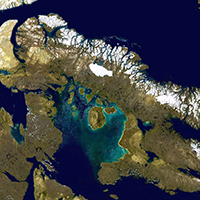Physical and chemical characteristics of 1300 lakes and ponds across the Canadian Arctic
Characteristics of Canadian Arctic lakes and ponds

Accepted: 25 August 2020
Supplementary: 107
HTML: 255
All claims expressed in this article are solely those of the authors and do not necessarily represent those of their affiliated organizations, or those of the publisher, the editors and the reviewers. Any product that may be evaluated in this article or claim that may be made by its manufacturer is not guaranteed or endorsed by the publisher.
Authors
Lakes and ponds are a major feature of the Arctic landscape and are recognized as effective ‘sentinels of change’. Here we present water chemistry characteristics of lakes and ponds (n=1300 with 26 variables) across the Canadian Arctic collated from published studies. We also extracted geological and ecoregion data in an attempt to determine the key drivers. In general, most lakes were shallow (85.4%, <10 m), nutrient (phosphorus) poor (oligotrophic = 45.6% and ultra-oligotrophic = 24.8%), located at low elevation (66.5%, <200 m asl), close to coastlines (72.5%, 0-50 km), and underlain by sedimentary geology (66.5%). The first two components from Principal Component Analysis explained 49.3% of the variation in the dataset; the first component was dominated by conductivity/carbonate materials, and the second component suggested allochthonous inputs of phosphorus. In general, bedrock geology is the primary driver of water chemistry; as such, there were major differences between lakes underlain by igneous and sedimentary rocks. Those on sedimentary bedrock tend to have higher pH, nutrients and higher inorganic ion concentrations.
Edited by
Michela Rogora, CNR-IRSA Verbania, ItalyHow to Cite
Similar Articles
- Luciana Avigliano, Alicia Vinocour, Griselda Chaparro, Guillermo Tell, Luz Allende, Influence of re-flooding on phytoplankton assemblages in a temperate wetland following prolonged drought , Journal of Limnology: Vol. 73 No. 2 (2014)
- Michela Rogora, Lyudmila Kamburska, Rosario Mosello, Gabriele Tartari, Lake Orta chemical status 25 years after liming: problems solved and emerging critical issues , Journal of Limnology: Vol. 75 No. s2 (2016): Lake Orta: a new lease on life
- Man Zhang, Qiu-Qi Lin, Li-Juan Xiao, Sheng Wang, Xin Qian, Bo-Ping Han, Effect of intensive epilimnetic withdrawal on phytoplankton community in a (sub)tropical deep reservoir , Journal of Limnology: Vol. 72 No. 3 (2013)
- Mattia M. Azzella, Rossano Bolpagni, Alessandro Oggioni, A preliminary evaluation of lake morphometric traits influence on the maximum growing depth of macrophytes , Journal of Limnology: Vol. 73 No. 2 (2014)
- Pietro Volta, Norman D. Yan, John M. Gunn, Past, present and future of the fish community of Lake Orta (Italy), one of the world’s largest acidified lakes , Journal of Limnology: Vol. 75 No. s2 (2016): Lake Orta: a new lease on life
- Ali Oveisy, Leon Boegman, One-dimensional simulation of lake and ice dynamics during winter , Journal of Limnology: Vol. 73 No. 3 (2014)
- Marina Manca, Michela Rogora, Nico Salmaso, Inter-annual climate variability and zooplankton: applying teleconnection indices to two deep subalpine lakes in Italy , Journal of Limnology: Vol. 74 No. 1 (2015)
- Didier L. Baho, Stina Drakare, Richard K. Johnson, Craig R. Allen, David G. Angeler, Is the impact of eutrophication on phytoplankton diversity dependent on lake volume/ecosystem size? , Journal of Limnology: Vol. 76 No. 1 (2017)
- Mattia M. Azzella, Italian Volcanic lakes: a diversity hotspot and refuge for European charophytes , Journal of Limnology: Vol. 73 No. 3 (2014)
- Alicja Bonk, Wojciech Tylmann, Benjamin Amann, Dirk Enters, Martin Grosjean, Modern limnology and varve-formation processes in Lake Żabińskie, northeastern Poland: comprehensive process studies as a key to understand the sediment record , Journal of Limnology: Vol. 74 No. 2 (2015)
<< < 4 5 6 7 8 9 10 11 12 13 > >>
You may also start an advanced similarity search for this article.
-
Jonathan B. Martin, Andrea J. Pain, Ellen E. Martin
-
Zhizhong Li, Madjid Hadioui, Kevin J. WilkinsonNanomaterials : 2023

 https://doi.org/10.4081/jlimnol.2020.1973
https://doi.org/10.4081/jlimnol.2020.1973





